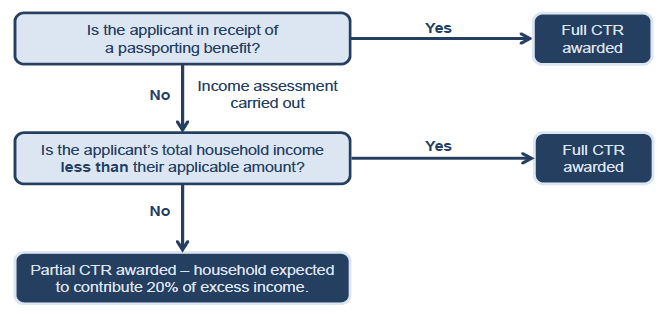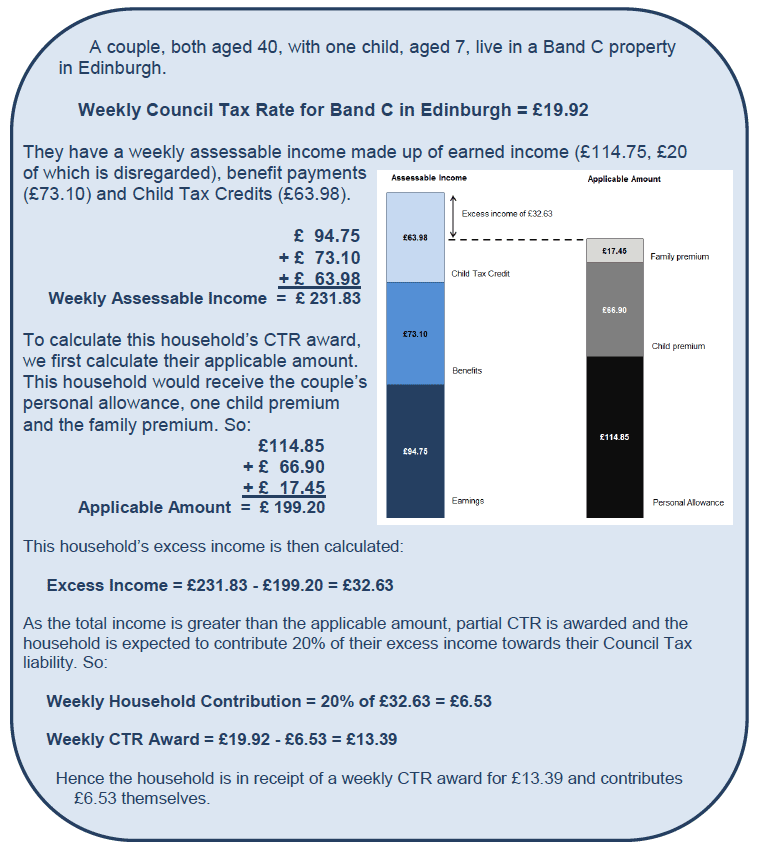Council tax reduction in Scotland: 2016-2017
Provides statistics on the Council Tax Reduction (CTR) scheme, which reduces the council tax liability of low-income households in Scotland.
This document is part of a collection
1. Introduction
Council Tax Reduction ( CTR) provides low income households with a reduction in their Council Tax liability. The reduction can be any proportion of the liability, up to and including 100% ( i.e. the household has their Council Tax liability reduced to £0).
The Scottish Government introduced CTR on 1 st April 2013 to replace Council Tax Benefit ( CTB). CTB was implemented by the Department for Work and Pensions ( DWP) and was abolished under the provisions of the UK Welfare Reform Act 2012. Entitlement to CTR in Scotland replicates, as far as possible, previous entitlement to CTB. This reflects a variety of circumstances, including unemployment, low pay and inability to work because of disability or caring commitments.
1.1 How CTR awards are calculated
Entitlement to CTR and the amount awarded is based on the status and income of the applicant and their household. Figure 1 shows the process an application goes through to calculate whether CTR should be awarded and, if so, how much.
Figure 1: Process for calculating CTR awards

Note: simplified version, not accounting for capital rules, non-dependant deductions and second adult rebate.
Some useful explanations on the terms used when describing CTR:
Passporting benefits - receipt of one of the following benefits automatically qualifies the recipient for full CTR:
- Income-based Jobseeker's Allowance - paid to those who are unemployed and are on a low income.
- Income-related Employment and Support Allowance - paid to those on a low income whose ability to work is limited by illness or disability.
- Income Support - paid to those on a low income and under state pension age.
- Pension Credit (Guarantee Credit) - paid to those on a low income who are over the qualifying age.
Applicable Amount - The amount of money that the government says is required for a household to live on. This is a personal allowance - which varies depending on age and family status - with the potential for premiums to be added. For example, if the applicant is a carer, they would receive the relevant personal allowance plus the carer premium. Some examples of personal allowances and premiums for 2016-17 are given in Table 1 alongside their equivalents for 2017-18.
Table 1: Examples of CTR Applicable Amounts components, 2016-17 and 2017-18
| Personal Allowances | 2016-17 | 2017-18 |
|---|---|---|
| Single claimant aged less than 25 years | £57.90 | £57.90 |
| Single claimant aged not less than 25 years | £73.10 | £73.10 |
| Single claimant aged 60 years to 64 years | £155.60 | £159.35 |
| Single claimant aged 65 years or over | £168.70 | £172.55 |
| Couple both aged less than 18 years | £87.50 | £87.50 |
| Couple at least one aged 18 years | £114.85 | £114.85 |
| Couple at least one aged 60 years to 64 years | £237.55 | £243.25 |
| Couple at least one aged 65 years or over | £252.30 | £258.15 |
| Child or young person (from birth to the day before their 20th birthday) | £66.90 | £83.63 |
| Premiums | 2016-17 | 2017-18 |
| Family Premium (claimants with children) | £17.45 | £17.45 |
| Disability Premium for single person | £32.25 | £32.55 |
| Disability Premium for couple | £45.95 | £46.40 |
| Enhanced Disability Premium for single person | £15.75 | £15.90 |
| Enhanced Disability Premium for couple | £22.60 | £22.85 |
| Enhanced Disability Premium for child | £24.43 | £24.78 |
| Severe Disability Premium for single person | £61.85 | £62.45 |
| Severe Disability Premium for couple where one qualifies | £61.85 | £62.45 |
| Severe Disability Premium for couple where both qualify | £123.70 | £124.90 |
| Carer Premium | £34.60 | £34.95 |
| Disabled Child Premium | £60.06 | £60.90 |
Excess Income - The amount left after deducting the household's applicable amount from their total income. The household's total income is calculated as the total income from employment, pensions and benefits (although some benefit income may be disregarded).
Income Assessment - Undergone by applicants not in receipt of a passporting benefit, and who have less than £16,000 in savings, to determine their eligibility for CTR. The 'means-test' assessment compares the household's assessable income (as defined under CTR) and their applicable amount.
- If total income < applicable amount then full CTR will be awarded.
- If total income > applicable amount then the household is expected to contribute 20 per cent of their excess income to their Council Tax bill. This results in a tapering effect, where CTR awards decrease as income increases.
Full CTR - The amount of CTR awarded is equal to the full amount of Council Tax liability for the applicant. For example, if the applicant lived in a Band C house in Edinburgh, their weekly Council Tax liability was £19.92 (£20.53 in 2017-18). If they received full CTR, their CTR award would equal their liability (£19.92) and the household's contribution would be zero.
Partial CTR - The household contributes 20% of their excess income towards their Council Tax liability and the remainder of the liability is the CTR award. Figure 2 provides an illustrative example of a partial CTR calculation.
Figure 2: Illustrative example of CTR Income Assessment

Contact
There is a problem
Thanks for your feedback